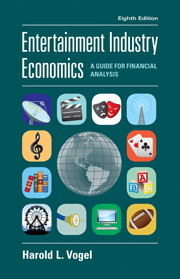Book contents
- Frontmatter
- Contents
- Preface
- Entertainment Industry Economics
- PART I Introduction
- PART II Media-dependent entertainment
- PART III Live entertainment
- Chapter 11 Gaming and wagering
- Chapter 12 Sports
- Chapter 13 Performing arts and culture
- Chapter 14 Amusement/theme parks
- PART IV Roundup
- Appendix A Sources of information
- Appendix B Major games of chance
- Appendix C Supplementary data
- Glossary
- References
- Index
- References
Chapter 12 - Sports
from PART III - Live entertainment
Published online by Cambridge University Press: 01 June 2011
- Frontmatter
- Contents
- Preface
- Entertainment Industry Economics
- PART I Introduction
- PART II Media-dependent entertainment
- PART III Live entertainment
- Chapter 11 Gaming and wagering
- Chapter 12 Sports
- Chapter 13 Performing arts and culture
- Chapter 14 Amusement/theme parks
- PART IV Roundup
- Appendix A Sources of information
- Appendix B Major games of chance
- Appendix C Supplementary data
- Glossary
- References
- Index
- References
Summary
It ain't over ‘til it's over.
– Yogi BerraIn sports today, chances are the game's not over 'til there's another television commercial.
This chapter concentrates on sports, which is as much an entertainment business as any thus far discussed. The exposition underscores the importance of links to broadcasting, cable, and wagering segments and illustrates how tax-law considerations are at the core of many sports business decisions. But it also indicates why professional sports may be the only business “where the owners want regulation, and labor – the players – want the free market.”
Spice is nice
Early innings
Trivia buffs might delight in learning that the first recorded Olympic running event occurred in Olympia, Greece, in 776 B.C. Yet sporting activities had by then already been developing for thousands of years – from the earliest days of history and from a time when spears, clubs, and bows and arrows were used in the provision of food and shelter.
It has indeed been a long journey from those early, primitive times to today's organized professional leagues, whose games are instantly televised to a global audience. But actually, it was not until the middle of the nineteenth century that the modern organizations first evolved, primarily in the United States and the United Kingdom. The catalyst was the Industrial Revolution, which expanded the middle class and, accordingly, the leisure time available. As roads and automobiles and other modern forms of communication and travel were invented and then perfected, rates of growth accelerated.
- Type
- Chapter
- Information
- Entertainment Industry EconomicsA Guide for Financial Analysis, pp. 448 - 478Publisher: Cambridge University PressPrint publication year: 2010



